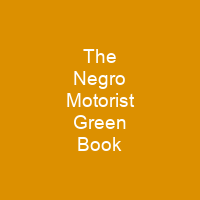The Green Book was an annual guidebook for African-American roadtrippers. It was originated and published by New York City mailman Victor Hugo Green from 1936 to 1966. The book was little known outside the African- American community. It is now being digitized and republished by the Public Library of New York and is available for download on the Internet.
About The Negro Motorist Green Book in brief

After the end of legal slavery in the North and later in the South after the Civil War, most freed black men continued to live at little more than a subsistence level. They could plan leisure excursions for the first time. They were aided in this measure by the 1875 Well-to-do Act of 1875, which had made it illegal to discriminate against African-Americans in public accommodations and public transportation. In the pre-Jim Crow era this meant mingling with whites in hotels, hotels, resorts, and other leisure facilities. They encountered a backlash, particularly in the Gulf of Mexico, for instance traveling by rail from New Orleans to resorts along the coast of the Gulf. Black Americans employed as athletes, entertainers, and salesmen also traveled frequently for work purposes. They faced hardships such as white-owned businesses refusing to serve them or repair their vehicles, and threats of physical violence and forcible expulsion from whites-only \”sundown towns\”. They were subjected to racial profiling by police departments, sometimes seen as ‘uppity’ or ‘too prosperous’ just for the act of driving, which many whites regarded as a white prerogative. They risked harassment or worse on and off the highway. Black travelers in the U.S. faced major problems unknown to most whites. As a result, simple auto journeys for black people were fraught with difficulty and potential danger. Black Americans were in danger if they stayed past sunset, and were found in sundown towns.
You want to know more about The Negro Motorist Green Book?
This page is based on the article The Negro Motorist Green Book published in Wikipedia (as of Nov. 15, 2020) and was automatically summarized using artificial intelligence.







